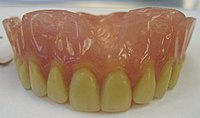
Photo from wikipedia
BACKGROUND/AIM Traumatic dental injuries occur frequently among young children. The aim of this study was to evaluate the impact of traumatic dental injuries on oral health-related quality of life (OHRQoL)… Click to show full abstract
BACKGROUND/AIM Traumatic dental injuries occur frequently among young children. The aim of this study was to evaluate the impact of traumatic dental injuries on oral health-related quality of life (OHRQoL) in preschool children using the Scale of Oral Health Outcomes for 5-year-old children (SOHO-5). MATERIALS AND METHODS This study involved 769 five-year-old children enrolled at public and private preschools. Two examiners underwent a training process which involved the determination of interexaminer and intra-examiner agreement (Kappa statistic) for all clinical conditions (K > 0.82). Descriptive statistics were performed, followed by Poisson regression analysis (α = 5%). RESULTS The prevalence of the impact of oral problems on OHRQoL was 32.9% and 42.2% according to the parents/caregivers and children, respectively. Based on the children's self-reports, the occurrence of two or more injured teeth (PR = 1.30; 95% CI: 1.04-1.64), toothache (PR = 1.68; 95% CI: 1.35-2.09), and a low level of parent's schooling (PR = 1.54; 95% CI: 1.24-1.91) exerted impacts on OHRQoL. For the reports of parents/caregivers, the occurrence of non-complicated TDI (PR = 0.66; 95% CI: 0.44-0.98), toothache (PR = 8.03; 95% CI: 5.92-10.88), and a low level of parent's schooling (PR = 1.60; 95% CI: 1.17-2.17) remained associated with the final model. CONCLUSIONS The impact of oral problems on the OHRQoL of the preschool children was high. A greater number of injured teeth, the presence of toothache, and socioeconomic factors were associated with poorer OHRQoL, based on the reports of both the parents/caregivers and the children. The occurrence of non-complicated TDI was a protective factor for OHRQoL.
Journal Title: Dental Traumatology
Year Published: 2017
Link to full text (if available)
Share on Social Media: Sign Up to like & get
recommendations!